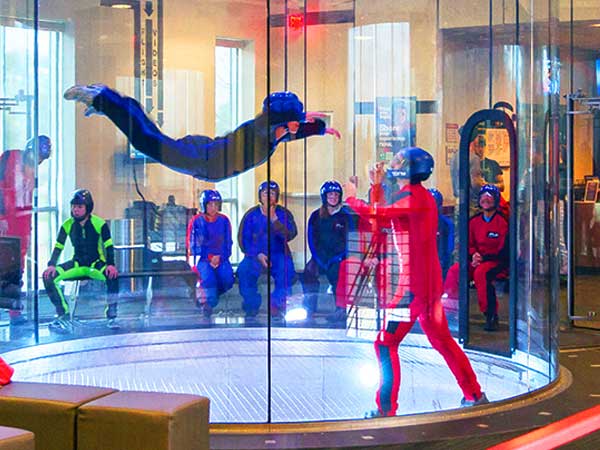VerticalWind Tunnel
A vertical wind tunnel (VWT) is a wind tunnel which moves air up in a vertical column. Unlike standard wind tunnels which have test sections that are oriented horizontally, as experienced in level flight, a vertical orientation enables gravity to be countered by drag instead of lift, as experienced in an aircraft spin or by a skydiver at terminal velocity.
Although vertical wind tunnels have been built for aerodynamic research, the most high-profile are those used as recreational wind tunnels, frequently advertised as indoor skydiving or body-flight, which have also become a popular training tool for skydivers.

RECREATIONAL VERTICAL WIND TUNNELS
TYPE
Outdoor vertical wind tunnels can either be portable or stationary. Portable vertical wind tunnels are often used in movies and demonstrations, and are often rented for large events such as conventions and state fairs. Portable units offer a dramatic effect for the flying person and the spectators, because there are no walls around the flight area. These vertical wind tunnels allow people to fly with a full or partial outdoor/sky view. Outdoor vertical wind tunnels may also have walls or netting around the wind column, to keep beginner tunnel flyers from falling out of the tunnel.
Stationary indoor vertical wind tunnels include recirculating and non-recirculating types. Non-recirculating vertical wind tunnels usually suck air through inlets near the bottom of the building, through the body-flight area, and exhaust through the top of the building. Recirculating wind tunnels form an aerodynamic loop with turning vanes, similar to a scientific wind tunnel, but using a vertical loop with a body-flight chamber within a vertical part of the loop. Recirculating wind tunnels are usually built-in climates that are too cold for non-recirculating wind tunnels. The airflow of an indoor vertical wind tunnel is usually smoother and more controlled than that of an outdoor unit. Indoor tunnels are more temperature-controllable, so they are operated year-round even in cold climates.
Various propellers and fan types can be used as the mechanism to move air through a vertical wind tunnel. Motors can either be diesel-powered or electric-powered, and typically provide a vertical column of air between 6 and 16 feet wide. A control unit allows for air speed adjustment by a controller in constant view of the flyers. Wind speed can be adjusted at many vertical wind tunnels, usually between 130 and 300 km/h (80 and 185 mph, or 35 and 80 m/s), to accommodate the abilities of an individual and to compensate for variable body drag during advanced acrobatics.
